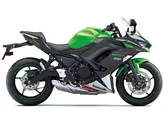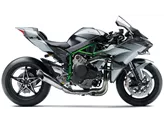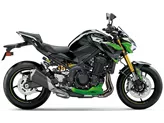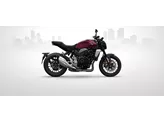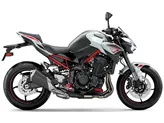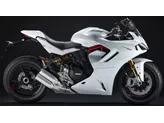Kawasaki Ninja ZX-6R 636 2013 vs. Kawasaki Z900 SE 2022

Kawasaki Ninja ZX-6R 636 2013

Kawasaki Z900 SE 2022
Overview - Kawasaki Ninja ZX-6R 636 2013 vs Kawasaki Z900 SE 2022
The Kawasaki Ninja ZX-6R 636 model year 2013 and the Kawasaki Z900 SE model year 2022 are both impressive motorcycles, but they have some key differences in terms of specifications and features.
Starting with the engine and drivetrain, both models have an inline four-cylinder engine. However, the Ninja ZX-6R 636 has a smaller displacement of 636cc compared to the Z900 SE's larger 948cc engine. The Z900 SE also has a slightly higher torque output of 98.6 Nm compared to the Ninja ZX-6R 636's 71 Nm. However, the Ninja ZX-6R 636 has a higher horsepower rating of 131 HP compared to the Z900 SE's 125.4 HP. Both bikes have liquid cooling and a compression ratio suitable for their respective engine types.
In terms of suspension, both models feature upside-down telescopic forks at the front. However, the Ninja ZX-6R 636 offers more adjustability with compression, preload, and rebound adjustments for both the front and rear suspension. The Z900 SE, on the other hand, only offers preload and rebound adjustments for the rear suspension. This gives the Ninja ZX-6R 636 an advantage in terms of fine-tuning the suspension for different riding conditions.

Kawasaki Ninja ZX-6R 636 2013
When it comes to the chassis, the Ninja ZX-6R 636 features an aluminum frame with a twin-tube, perimeter, extruded design. On the other hand, the Z900 SE has a steel frame with a double cradle design. Both frames are sturdy and provide good stability, but the aluminum frame of the Ninja ZX-6R 636 may offer slightly better weight savings and handling characteristics.
In terms of braking, both models have double disc brakes at the front with four-piston calipers. However, the Ninja ZX-6R 636 utilizes radial, monoblock, petal technology from Nissin, while the Z900 SE uses petal technology from Brembo. Both braking systems are effective and provide strong stopping power.
In terms of advanced rider assistance systems, the Ninja ZX-6R 636 only offers traction control, while the Z900 SE comes equipped with ABS, riding modes, ride by wire, and traction control. This gives the Z900 SE an advantage in terms of safety and customization options.
In terms of dimensions and weights, the Z900 SE has a slightly larger wheelbase of 1450mm compared to the Ninja ZX-6R 636's 1395mm. The seat height of the Z900 SE is also lower at 795mm compared to the Ninja ZX-6R 636's 830mm. However, the Z900 SE is heavier with a kerb weight of 210kg compared to the Ninja ZX-6R 636's 194kg (both weights include ABS).

Kawasaki Z900 SE 2022
In terms of strengths, the Ninja ZX-6R 636 is known for its sharpened geometry, good handling, and uncompromising reliability. The Z900 SE, on the other hand, boasts a powerful engine, high-quality chassis components, strong brakes, good ergonomics, and easy handling on the racetrack.
In terms of weaknesses, the Ninja ZX-6R 636 is criticized for its high purchase price, while the Z900 SE is noted to be missing a quickshifter.
Overall, both the Kawasaki Ninja ZX-6R 636 2013 and the Kawasaki Z900 SE 2022 are impressive motorcycles with their own unique strengths and weaknesses. The choice between the two ultimately depends on the rider's preferences, intended use, and budget.
Technical Specifications Kawasaki Ninja ZX-6R 636 2013 compared to Kawasaki Z900 SE 2022
Pros and Cons in comparison
Pros and Cons in comparison
Kawasaki Ninja ZX-6R 636 2013

The Kawa convinces with its good handling and uncompromising reliability. A strong motorbike, but definitely not a bargain.
Kawasaki Z900 SE 2022

The SE is a worthy further development of the already very sporty and good-natured Kawasaki Z900. But now sporty owners can also do fast laps on trackdays without making any major compromises. The components from Öhlins and Brembo bring real added value, so that the only thing missing is the quickshifter.
Price Comparison Avarage Market Price Kawasaki Ninja ZX-6R 636 vs Kawasaki Z900 SE
There are a few key differences between a Kawasaki Ninja ZX-6R 636 2013 and a Kawasaki Z900 SE 2022. It takes less time to sell a Kawasaki Z900 SE with 89 days compared to 122 days for the Kawasaki Ninja ZX-6R 636. Since model year 2013 1000PS.de editors have written 7 reviews for the Kawasaki Ninja ZX-6R 636 and 12 reviews for the Kawasaki Z900 SE since model year 2022. The first review for the Kawasaki Ninja ZX-6R 636 was published on 12/3/2012 and now has more than 20,800 views. This compares to more than 37,200 views for the first review on Kawasaki Z900 SE published on 9/16/2021.







